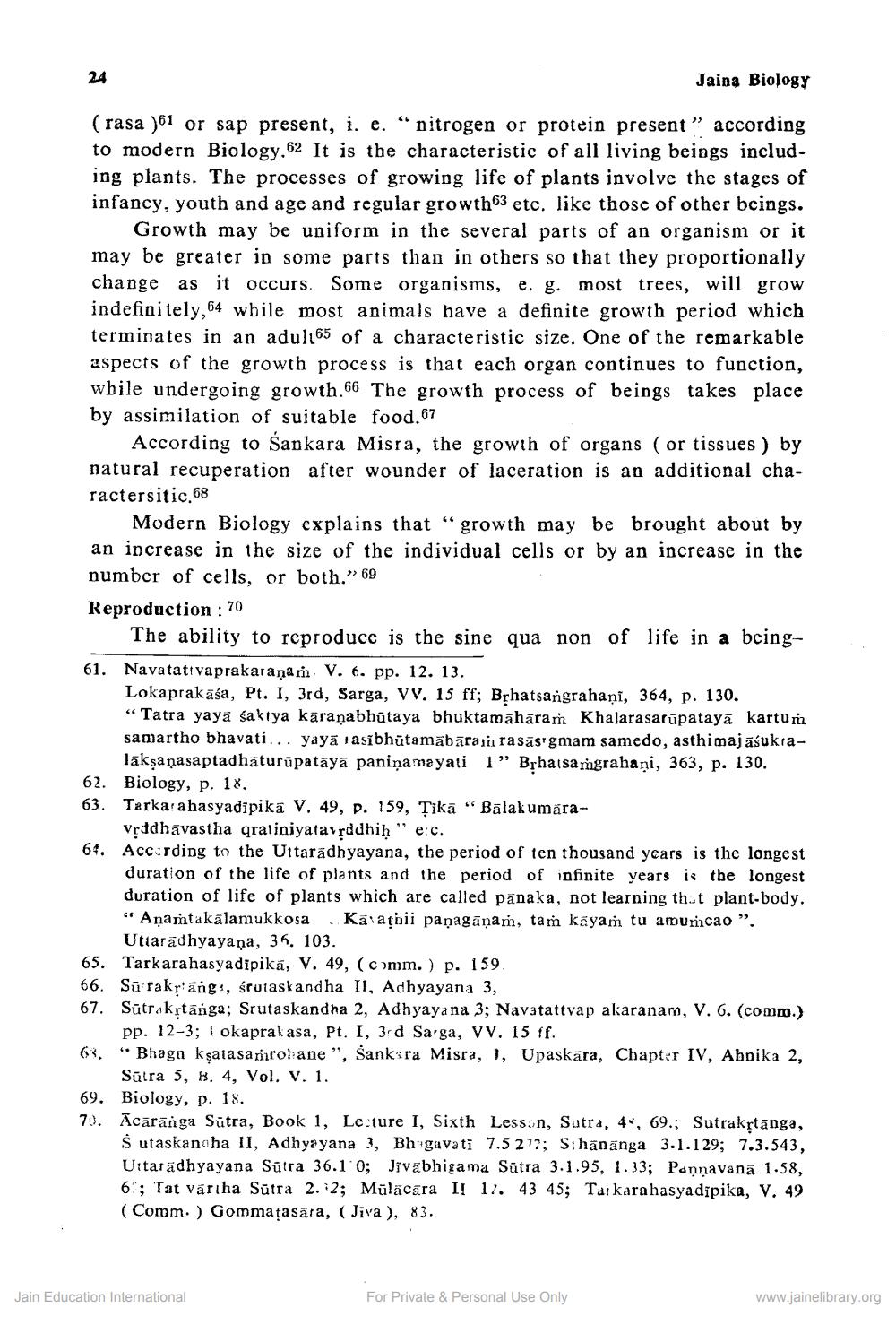________________
Jaina Biology
(rasa )61 or sap present, i. e. "nitrogen or protein present" according to modern Biology.62 It is the characteristic of all living beings including plants. The processes of growing life of plants involve the stages of infancy, youth and age and regular growth 63 etc. like those of other beings.
Growth may be uniform in the several parts of an organism or it may be greater in some parts than in others so that they proportionally change as it occurs. Some organisms, e. g. most trees, will grow indefinitely, 64 while most animals have a definite growth period which terminates in an adult65 of a characteristic size. One of the remarkable aspects of the growth process is that each organ continues to function, while undergoing growth.66 The growth process of beings takes place by assimilation of suitable food. 67
According to Sankara Misra, the growth of organs (or tissues ) by natural recuperation after wounder of laceration is an additional charactersitic.68
Modern Biology explains that “growth may be brought about by an increase in the size of the individual cells or by an increase in the number of cells, or both.” 69 Reproduction : 70
The ability to reproduce is the sine qua non of life in a being
61. Navatati vaprakaranan V. 6. pp. 12. 13.
Lokaprakāśa, Pt. I, 3rd, Sarga, vv. 15 ff; Brhatsangrahani, 364, p. 130. "Tatra yaya sakıya karaṇabhūtaya bhuktamāhāram Khalarasarūpatayā kartum samartho bhavati... yayā lasībhūtamābāram rasās'gmam samedo, asthimajāśukra
lākṣaṇasaptadhāturūpatāyā paniņa mayati 1” Brhaisamgrahaņi, 363, p. 130. 62. Biology, p. 18. 63. Tarka: ahasyadipikā V, 49, P. 159, Tika "Bālakumara
Věddhavastha qratiniyatavrddhih" e c. 64. According to the Uttaradhyayana, the period of ten thousand years is the longest
duration of the life of plants and the period of infinite years is the longest duration of life of plants which are called panaka, not learning that plant-body. “Anamtakalamukkosa Kaathii panagānam, tam kayam tu amumcao”.
Uttaradhyayaņa, 36. 103. 65. Tarkarahasyadipika, V. 49, (comm.) p. 159 66. Sūtrakrange, śrutaskandha II, Adhyayana 3, 67. Sūtrakstanga; Srutaskandha 2, Adhyayana 3; Navatattvap akaranam, V. 6. (comm.)
pp. 12-3; I okaprakasa, Pt. I, 3.d Sarga, vv. 15 ff. 63. " Bhagn kşatasarrovane ", Sankara Misra, 1, Upaskāra, Chapter IV, Abpika 2,
Sūtra 5, B. 4, Vol. v. 1. 69. Biology, p. 18. 70. Acārānga Sūtra, Book 1, Lecture I, Sixth Lesson, Sutra, 4., 69.; Sutrakrtānga,
Sutaskanoha II, Adhyayana ?, Bhagavati 7.5 272; Sthânānga 3.1.129; 7.3.543, Uttaradhyayana Sūtra 36.1 0; Jivabhigama Sutra 3.1.95, 1.33; Pannavanā 1.58, 6°; Tat várıha Sūtra 2.2; Mūlācāra I! 17. 43 45; Ta, karahasyadîpika, V. 49 (Comm.) Gommatasära, (Jiva ), 83.
Jain Education International
For Private & Personal Use Only
www.jainelibrary.org




